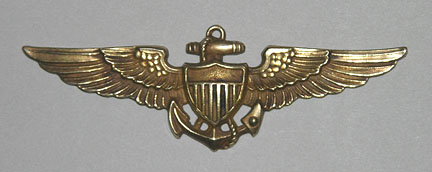Pacific Glory
by Anthony Saunders
On 23 December 1942, just days after their infamous attack on Pearl Harbor, the Japanese captured Wake Island, a small, but strategic coral atoll in the western Pacific. Fought at the beginning of June 1942, the battle of Midway marked the turning of the tide. Over the next two years, the US Navy would build the largest naval force the Pacific had ever seen and one by one, island by island, base by base, the Allies would slowly advance in some of the bloodiest and most costly campaigns of World War 2.
|
| Overall size: 27" x 32¾" | ||
| Insured shipping is included for deliveries in the lower 48 states (a $180 value). For other deliveries please call for a shipping quote. | ||
| Museum Presentation | Signed by Hellcat pilot Leslie Fortner framed with the signature of Alex Vraciu & WWII USN wings |
 |
Original WWII US Navy pilot wings Wing-tip to wing-tip measurement 2¾" |
Alex Vraciu signature Original signature included in the mount. The photograph reproduced on this card was reportedly taken as Vraciu exited his Hellcat following his participation in the 'Mission beyond darkness'. |
 |
| The Signatories |
Lt. Alex Vraciu USN Vraciu enlisted in 1941 and was commissioned as a Naval Reserve ensign in August 1942, and promoted at the end of March 1943. He received orders to report to Fighting Squadron 3 (VF-3) commanded by Lieutenant Commander Edward "Butch" O'Hare, who chose Vraciu as his wingman and gave him valuable advice regarding air combat tactics. Vraciu's first air-to air combat took place over Wake Island in October 1943, flying from the light aircraft carrier USS Independence. He scored his first victory on October 5, 1943, when he and O'Hare encountered an enemy formation. O'Hare flew below the clouds to find a Japanese Zero and Vraciu lost sight of him. Vraciu followed a second Zero to Wake Island, where it landed, and strafed the Zero on the ground. Vraciu also destroyed his first Mitsubishi Betty bomber while it was parked on the runway. During a mission in the Gilbert Islands on November 20, 1943, he downed another Betty. Vraciu's most successful day as an aviator occurred on June 19, 1944, during the First Battle of the Philippine Sea, also known as the "Great Marianas Turkey Shoot." Despite a malfunctioning supercharger, he intercepted a formation of Japanese dive bombers and destroyed six in a period of eight minutes. After Vraciu landed, the ordnancemen on Lexington discovered that he had used only 360 rounds of ammunition. On June 20, 1944, while escorting bombers in an attack on the Japanese Mobile Fleet (Kido Butai), Vraciu downed his nineteenth plane, making him the leading U.S. Navy ace, although he held that title for only four months. Vraciu was nominated Vraciu returned to combat in the Pacific in late 1944, flying Grumman F6F Hellcats in VF-20. On December 14, 1944, after two missions with VF-20, his plane was downed by anti-aircraft fire during a mission over the Philippines. Vraciu parachuted from his plane, landing in the Tarlac province of Luzon. He was rescued by Filipino resistance fighters, who appointed him a brevet major in command of a guerrilla unit. After spending five weeks with the guerrilla fighters, Vraciu rejoined American military forces and returned to the USS Lexington. He spent the last few months of the war serving at the Naval Air Test Center in Patuxent, Maryland. |
| Commander Leslie Fortner USN Joining the Navy in 1943, Les Fortner joined VC-88 flying Wildcats off the escort carrier USS Hoggatt Bay in the S.W. Pacific theatre. In early 1945 he flew in support of the landings at Iwo Jima, Okinawa and Lingayen, destroying several Japanese aircraft on the ground. Les flew over 100 combat missions during the war, and in April 1945 he shot down a Kamikaze 'Nick' off Kerama Rhetto near Okinawa. |
